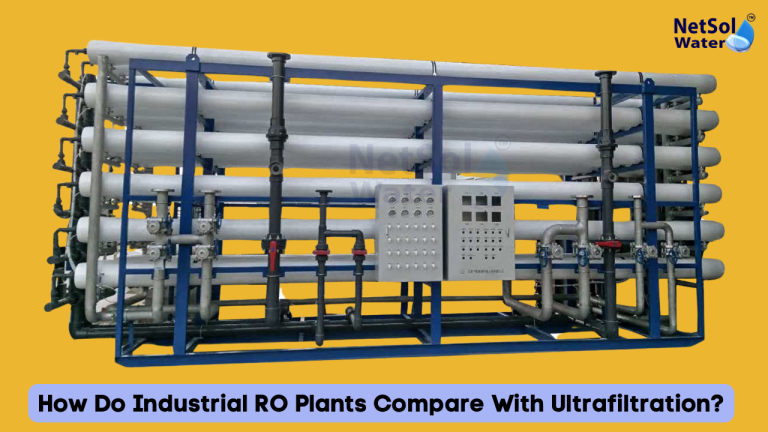
Numerous procedures in factories & plants are influenced by industrial water treatment. One of the top producers of these systems is Commercial RO Plant. We collaborate with customers to create & provide dependable solutions. We are aware of how important selecting the appropriate approach is. The decision has an impact on cost, efficiency, & water quality. In this blog we will read about how do industrial ro plants compare with ultrafiltration.
By reducing undesirable particles to get it removed from the system, industrial RO plants & ultrafiltration provides clean fresh water. However, they vary in their methods & outcomes. These two technologies will be compared in this blog. We’ll look at how they work, what they take away, how much energy they consume, along with how well they perform for certain jobs.
Mechanism of Filtration
A solid refining method for water is the first known phase in the treatment of industrial water. It is fundamental to understand & know the complete filtration mechanism. It outlines the capabilities & limitations of each system. Let’s examine a few of these systems’ mechanisms.
Industrial Reverse Osmosis Action
A membrane partially-permeating is a chief component integrated & installed in every RO System where there are industrial or commercial. It pushes water through that barrier by applying a lot of pressure. Salts & dissolved plus suspended matter/particles are blocked & stopped by the membrane. It produces extremely pure water. Following this procedure, you will notice low ion levels.
Ultrafiltration Process & Action Involved in Industrial RO Plants & Ultrafiltration
A membrane is also necessary for ultrafiltration. Particles greater than a specific size are eliminated. It inhibits certain viruses & bacteria. Most salts can pass through it. It involves less pressure to function. Compared to RO, it consumes less energy.
Membranes that capture undesired material are used in both techniques. RO functions on a molecular level. The particle level is where ultrafiltration operates. Because of this distinction, each approach is appropriate for a certain task.
Resultant Water Quality Standards
Every effort or attempt circles around the standard quality of the treating water. It determines if treated water satisfies usage requirements. Let’s examine a few performance metrics for each system.
1) Levels of Purity
Almost all dispersed solids particles are nearly completely removed by reverse osmosis. Up to ~99 percent of all dissolved solids are reduced.
2) Security with Clarity in Water
Manl y microorganisms along with suspended particles are removed by ultrafiltration. Not all dissolved salts are eliminated. For many purposes, it continues to provide safe water. It frequently acts as a RO pretreatment.
There are precise guidelines for clean water quality. The highest purity is provided by RO. Safe water with less dissolved solids is produced by ultrafiltration.
3) Expenses of Energy & its Operations
Your bottom line is impacted by cost & energy consumption. Your power bill may increase if you run filters. They have an impact on maintenance expenses as well. Let’s examine a few of these factors.
A) Requirements for Pressure
Pressures above 150 psi are frequently required for reverse osmosis. Water is pumped through tight membranes by this pressure. It increases the amount of energy applied. Energy recovery devices are frequently installed by engineers. They contribute to cost reduction.
B) Reduced Pressure Requirements
Pressures between 30 to 80 psi are typical for ultrafiltration. Pumps operate at low levels. This configuration conserves energy. It also reduces wear-tear.
Over time, increased pressure results in significant costs. Low pressure lowers the cost. Your financial constraints & purity objectives will determine the option.
C) Upkeeping Maintenance & Duration of servicing
Long-term project success is shaped by maintenance requirements. A frequently malfunctioning system will be more expensive. Downtime might be forced. Let’s examine a few important points.
1) Cleaning of Membranes
Membranes utilized throughout reverse osmosis require routine cleaning. They deal with biofilm formation with scaling foulants. Flushing cycles & injecting of chemicals are needed. You will budget for periods of inactivity.
2) Easy Quick Backwash
Membranes for ultrafiltration require backwash cycles. They have little trouble handling suspended solids. Backwash is scheduled at regular intervals. Heavy chemical exposure is avoided.
Both systems require maintenance. RO requires more thorough cleaning. Ultrafiltration requires less complicated upkeep. The lifespan could be anything anywhere from five-ten years. These figures are increased with proper treatment.
Application & Suitability Regarding Industrial RO Plants & Ultrafiltration
Value is created when a system is matched to its task with exact tool in need. Let’s examine a few typical applications.
1) Needs for High Purity
RO is applied when extremely low mineral levels are required. Boilers in power plants & the manufacturing of electronics are examples of this. RO is essential to industries that require ultra-pure water.
2) Clarification in Bulk
Ultrafiltration is the method of choice when turbidity plus microorganisms need to be eliminated. This is seen in cooling towers for beverage lines. It performs admirably as a RO plant pre-filter.
Every technique suits a set of goals. Cost, energy constraints, & purity objectives must all be considered. The project scale & feed water quality must also be reviewed.
Conclusion
This simply implies how do industrial RO plants compare with ultrafiltration when it comes in mechanism, energy need, output along with upkeep servicing or maintenance. The provision of clean water is their shared goal with that major objective. One of the top manufacturers of both solutions is Commercial RO Plant. We help you make the best decision. We create systems that satisfy your requirements. Commercial RO Plant provide dependable outcomes on schedule. Get professional assistance right now. To find out more about the differences between industrial RO systems & ultrafiltration, schedule a consultation. Allow us to assist you in choosing the right platform for your project.
